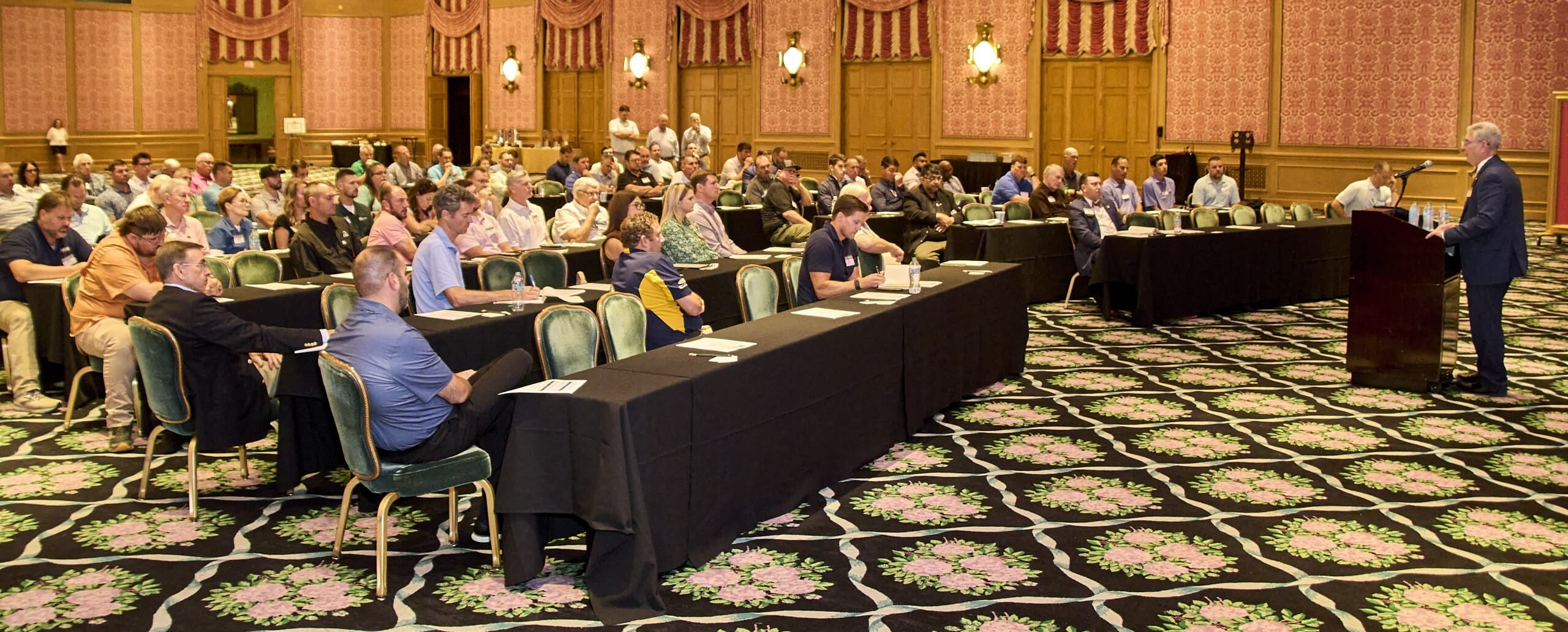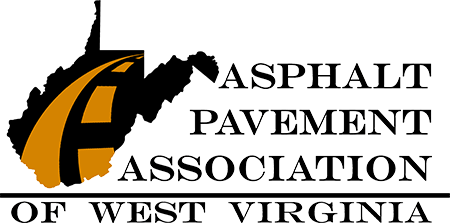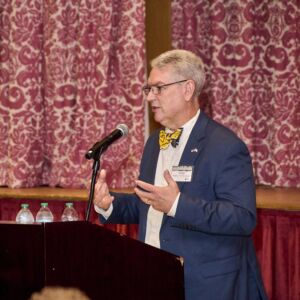CAWV Highway Division – WVDOT Secretary Remarks
On July 12, the CAWV Highway/Heavy Division met in conjunction with the CAWV Annual meeting at The Greenbrier. Division Chairman Ryan Cocco called the Division meeting to order, providing opening remarks and introducing our quest speaker, Secretary of Transportation, Todd Rumbaugh, P.E.
Secretary Rumbaugh began by thanking CAWV and its members for the opportunity to speak with our group and attend the Annual Meeting. The Secretary then talked about his experience thus far in the role, which included dealing with one of the worst winter WV has had in a decade, numerous major flooding events, a mudslide which blocked the turnpike for hours and a massive hole forming in the Eugen Carter Bridge deck among other problems. All of which happened since January 13th when Rumbaugh stepped into the role. The Secretary said he is nevertheless honored and privileged to be serving WV in this role.
WVDOH Program
The Secretary shifted his discussion to the highway program, starting with what the DOH had obligated thus far in fiscal year 2025, namely $285 million dollars paving and $220 million in bridge work, with another $85M and $50M, respectively, to come out. Other categories were as follows:
- $58M for traffic – Signals, stripping, etc.
- $9M Community development – lights, sidewalks, ADA compliance work, etc.
- $9M Localized mobility – Slide repair, resiliency, expansion
Rumbaugh also mentioned the upcoming August Federal Redistribution, an annual process where the Federal Highway Administration reallocates unused federal highway funds to states preventing them from lapsing back to the federal government. This process will likely grant the WVDOH around $70M.
The Secretary also discussed the $100M transfer from the state’s General Fund Surplus, noting that of the 261 total projects covered by the transfer, 41 have already been completed. Of the remaining, 123 projects have been distributed to industry, many currently underway, 71 are left to be distributed, and 26 projects will be completed by WVDOH state forces.

“Fixing the Motor While its Running” - Shifting from Expansion to Preservation
While the Secretary was able to offer details for the ongoing program, the future 2026 program was a different story, and is still under development. Initially, the Secretary alluded to an infrastructure condition report showing that WV interstate pavement conditions had dropped from 73.8 percent good at the introduction of Roads to Prosperity to 68.9 percent in 2024, and most recently to 61.8 percent. While Bridge conditions fared better, WV is still ranked 47th or 48th in the nation. Rumbaugh said that the likely reason was that the previous administration “over invested in expansion and didn't invest enough in reconstruction, paving and taking care of what we should have took care of.”
Rumbaugh noted that if WVDOH didn’t shift their current trajectory and recover the roadway and bridge conditions, FHWA could reduce their participation rates with project costs, i.e. 80% Federal funds, 20% State fund. Rumbaugh said FHWA could reduce their participation rate down to 65%, forcing WVDOH to absorb an additional 15% of project costs.
With limited state funds, a reduced to the federal match would be detrimental to the state, so the WVDOH is making major shifts to focus on preserving and maintaining current assets while placing major expansion in the slow lane. Rumbaugh pointed to the recent Amendment 4, released in June, and a forthcoming Amendment 5 to the State’s Transportation Improvement Plan, STIP. Amendment 4 removed and/or dramatically reduced many expansion projects around the state, including the King Coal Highway, Coal Fields Expressway, Tulsa Highway, Route 2, among others. This initial step was to realign WVDOH goals to maintain federal funding. Currently under development, STIP Amendment 5, Rumbaugh stated would reinject funds removed during Amendment 4 back into the NHS system in places necessary to bolster road and bridge condition ratings to return West Virginia to federal compliance (>70% good pavements, <10% poor bridges).
Additionally, Rumbaugh, added that “working on all these sections simultaneously, is not getting any of them done and leaves roads to nowhere, which denies the state any economic benefit because of it.” While expansion may slow, Morrisey and Rumbaugh agreed that expansion is necessary for the growth of West Virginia and that Corridor H should become the primary focus for expansion and should remain the focus until it is complete. Once complete focus will shift in order to complete another corridor. Rumbaugh added “we are not stopping expansion, just refocusing on what really matters,” as there are still other expansion projects continuing around the state, some due to grant funding or other for the need for capacity improvements. One such project is the Twin Falls Connector project on the Coalfields Expressway which is still planning to go to bid in early fall.
Successor to IIJA
The Secretary touched on four aspects he would like to see built into the next federal highway bill. First, and likely the most desired across the nation is the removal of the separate “buckets” of money. The USDOT places restrictions on these various buckets and only allows funds from individual buckets to be utilized for certain work types. Rumbaugh said, “just give us [state DOT’s] one big bucket of money, we know where we need to use it and how to use it in the most efficient way.” Additionally , the current federal system only allows state DOTs to use two funding buckets on any given project, which restricts the scopes of projects or conversely restricts the funds available for projects with larger scopes. Rumbaugh elaborated that in some cases DOTs are forced to spend funds on unnecessary work just to be able to fund the work that is necessary.
The reinstatement of programmatic agreements for permitting was another point brought up by Rumbaugh. Permitting has been very cumbersome in recent years and has greatly delayed many projects around the state. The return of programmatic agreements between the state DOTs and federal entities like fish and wildlife, the Army Corp, etc. for permitting processing. This would allow DOTs to assume the responsibility of reviewing and issuing permits. Years ago, permitting was handled in this manner and a return of this practice would drastically speed up the permitting process and allow work to get started quicker.
Rumbaugh also noted that the existing bridge funding mechanism should remain intact. Currently this mechanism is handled separately from the normal funding mechanism and is based on a state’s bridge conditions and the state’s individual needs. Rumbaugh added that “West Virginia has received additional funding each year due to our bridge conditions, and it has helped.”
Rumbaugh’s final request was related to discretionary grants. While discretionary grants are generally controversial, a bipartisan bill will likely have to include them in order to pass. Fortunately, West Virginia has been successful over the years of IIJA, receiving roughly $150M per year in grants. The problem lies with the proportion of the grant size to the total project cost, as many grants received are relatively small which forces WVDOH to cover the difference. Rumbaugh gave an example where WVDOH received a $5 million grant for a bridge which had an estimated cost of $100 million. This forced WVDOH to dedicate $95 million to that project. Rumbaugh’s request is to require discretionary grants to cover at least 50 percent of a project’s cost. “I would rather only get 10 grants, that are at least 50 percent of the project costs, as it would be easier to guarantee those 10 projects would get the state funding match required.”
WVDOH Staffing / Consultant Usage
Rumbaugh also discussed ongoing WVDOH staff changes and division reorganization. Recent staffing appointments include Jake Bumgarner as State Highway Engineer, Ed Compton as Deputy State Highway Engineer of Development, Matt Crum as Deputy State Highway Engineer of Construction (accepted after the meeting). Jason Foster, Brian Cusick, and Travis Ray as District Engineers for District 2, 6 and 8 respectively.
One of the Secretary’s focuses when he started was to correct some sins of the past as it related to the neglect of WVDOH’s pay plan. For the past few years, WVDOH employees would receive promotions however would not receive the correct corresponding raise. Rumbaugh went back though and placed everyone where they should have been place according to the pay plan. Rumbaugh also added that he has begun to see ex-employees return to WVDOH and attitudes and morale increase within the DOH.
Another focus for the Secretary is communication and decision-making. Rumbaugh said, “I've been pushing more and more decisions making authority back down [the chain of command] and will continue to do that.” Rumbaugh also noted that he wants WVDOH staff to openly communicate with anyone. He said he has asked that district managers be represented at any community meetings and be willing to discuss this with anyone. “I have nothing to hide. I’ll tell you what I know, and I’ll tell you what I don’t know” Rumbaugh said, who has always valued transparence and is trying to instill that in other WVDOH staffers “just be transparent and do the right thing.”
The Secretary also discussed a forthcoming organizational restructuring for WVDOH. With funding levels decreasing as Roads to Prosperity comes to an end, the Secretary wants to pull back and centralize activities that had been pushed to the districts, allowing them to focus more on construction. In the same light Rumbaugh also addressed the reduction in consultant usage saying “we have been doing hundreds of millions of dollars worth of consultant work, but with budgets where they’re at that usage needs to decrease, and funds need to shift back into construction.” He elaborated saying that with the reduction of funding, back to pre-Roads to Prosperity levels sustaining the vast number of consultants being used will no longer be feasible. Rumbaugh also overviewed some of the changes to the consultant prequalification revisions as well as future implementation of quality measures for consultant selection, mentioning a measure of the number of change orders needed on a project and any adjustment needed in quantities due to a consultant’s plans.
Adjournment
Closing out the meeting, Ryan Cocco took a few moments to discuss the importance of the Joint Cooperative Committee between WVDOH, FHWA and CAWV members and encouraged participation within that committee or its subsequent subcommittees. Lastly, Cocco took a motion from the floor to appoint Jason Workman with Mountaineer Contractors as the next Chairman of the CAWV Highway Division.
Past Posts
The WVDOH announced an upcoming Materials Procedures (MP) Committee meeting. The meeting will be held in person on April 16 at 10:00 a.m. at the…
WVDOH has released the Asphalt, Concrete and Fuel price adjustment indices for the month of April 2025 as shown below.
Period – 4/1/2024
#2 Fuel (Gal) – $2.3297
Asphalt (Ton) – $579.00
Cement (Ton) – $195.28
Historical and individualized information can be found on our Index page.
Even with a winter storm that moved eastward over the area, nearly 200 individuals from industry, WVDOH, and academia joined together for the 45th Annual…
APAWV received a letter dated March 4, 2025 from the West Virginia Division of Highway’s materials division recently regarding Contractor’s responsibility to initiate and enter…
The WVDOH Standards & Manuals Committee’s next meeting will be held in person on April 2, 2025, at 9:00a.m. in Room 820 in Building 5…
WVDOH has released the Asphalt, Concrete and Fuel price adjustment indices for the month of March 2025 as shown below.
Period – 12/1/2024
#2 Fuel (Gal) – $2.6029
Asphalt (Ton) – $579.00
Cement (Ton) – $195.28
Historical and individualized information can be found on our Index page.
The WVDOH announces its March Specifications Committee meeting, which is scheduled for Wednesday, March 5 at 9:00 a.m. at the WVDOH Building 5 Conference Room…
The APAWV is pleased to offer, for the 31st year, a voluntary technical services program to assist you in completing the 2024 Emission Inventory. As…
If you are unable to join the industry at the 45th Annual Paving Conference, consider joining us virtually on Thursday February 20th from 8:00am –…
WVDOH has released the Asphalt, Concrete and Fuel price adjustment indices for the month of February 2025 as shown below.
Period – 12/1/2024
#2 Fuel (Gal) – $2.4103
Asphalt (Ton) – $578.00
Cement (Ton) – $195.28
Historical and individualized information can be found on our Index page.

